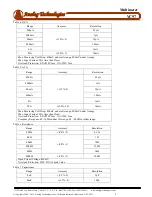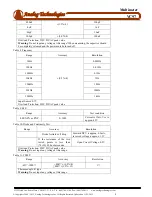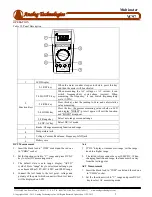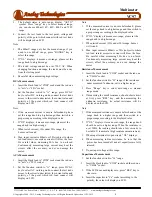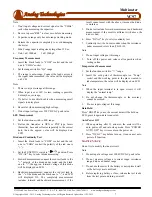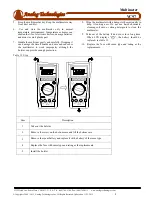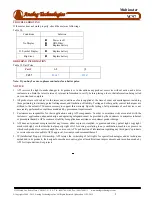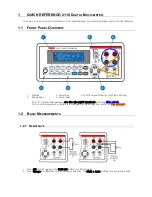
Copyrights 2000 – 2012, Analog Technologies, Inc. All Rights Reserved. Updated on 11/22/2012
6
Analog Technologies
VC97
Multimeter
2352 Walsh Ave. Santa Clara, CA 95051. U. S. A. Tel.: (408) 748-9100, Fax: (408) 748-9111 www.analogtechnologies.com
3. The default states is auto range, display “AUTO”
symbol. Press “range” key to select manual range,
you can choose 400mV, 4V, 40V, 400V and 750V
range.
4. Connect the test leads to the test point, voltage and
polarity of the point which connect with red test leads
will be displayed on LCD.
Note
1. The 400mV range only has the manual range, if you
need to use 400mV range, press “RANGE” key to
select this range.
2. If “OL” displays, it means over-range, please set the
range knob to a higher range.
3. The tested voltage cannot be over 750V AC. When
changing function and range, the leads must be away
from the testing point.
4. Be careful when measuring high voltage.
DCA Measurement
1. Insert the black lead to “COM” socket and the red one
to “mA” or “20A” socket.
2. Set the function switch to “A” range, press DC/AC
key to select DC working mode, connect the test leads
across to the circuit under tested, the current value and
polarity of the point which red lead connect will
display on LCD.
Note
1. If the measured current is unsure beforehand, please
set the range knob to a higher range, then switch to a
proper range according to the displayed value.
2. If “OL” displays, it means over-range, please set the
range knob to a higher range.
3. When tested current
≥
10A under 20A range, the
buzzer will sound.
4. Max. input current is 400mA or 20A (subject to where
red lead insert), excessive current will blow the fuse.
Be careful when measuring 20A due to un-fused.
Continuously measuring large current may heat the
circuit, affect the accuracy, and even damage the
meter.
ACA Measurement
1. Insert the black lead to “COM” socket and the red one
to “mA” or “20A” socket.
2. Set the function switch to “A” range, press DC/AC
key to select AC working mode, connect the test leads
across to the circuit under tested, the current value and
polarity of the point which red lead connect will
display on LCD.
Note
1. If the measured current is unsure beforehand, please
set the range knob to a higher range and then switch to
a proper range according to the displayed value.
2. If “OL” displays, it means over-range, please set the
range knob to a higher range.
3. When tested current
≥
10A under 20A range, buzzer
will sound.
4. Max. input current is 400mA or 20A (subject to where
red lead insert) excessive current will blow the fuse.
Be careful when measuring 20A due to un-fused.
Continuously measuring large current may heat the
circuit, affect the accuracy, and even damage the
meter.
Resistance Measurement
1. Insert the black lead to “COM” socket and the red one
to “V
Ω
Hz” socket.
2. Set the function switch to “
Ω
” range, if the resistance
under measured f unknown, set to a higher range.
3. Press “Range” key to select auto range or manual
range mode.
4. If measuring the small resistance, should short-circuit
at first, press “REL” key, and then measuring the
unknown resistance, its actual resistance will be
displayed on the LCD.
Note
1. If the measured resistance is unsure beforehand, set the
range knob to a higher range and then switch to a
proper range according to the displayed value.
2. If “OL” displays, it means over-range, the range knob
should be set to a higher range. When the resistance is
over 1M
Ω
, the reading should take a few seconds to
be stable. It is normal at high resistance measurement.
3. When input terminal is open circuit, “OL” displays.
4. When measuring in-line resistance, be sure that the
power has been turned off and all capacitors are fully
released.
5. Do not input voltage at this range.
Capacitance Measurement
1. Set the function switch to “
” range.
2. Insert the black lead to “COM” socket and the red one
to “V
Ω
Hz” socket.
3. If the LCD does not display zero, press “REL” key to
clear zero.
4. Insert the capacitor to “Cx” socket according to the
polarity, the value will display on LCD.



